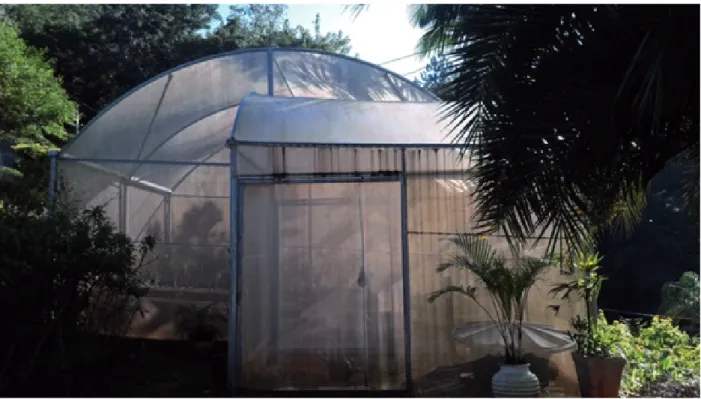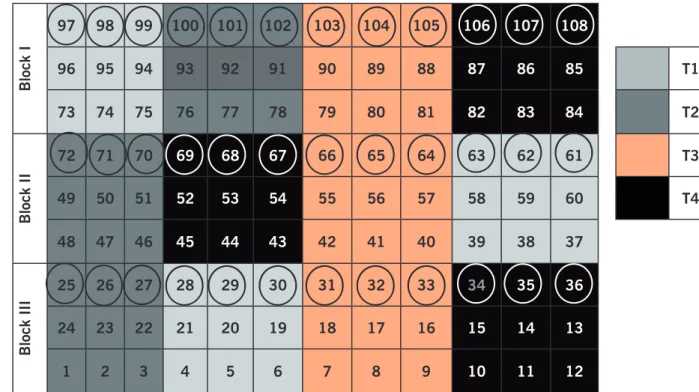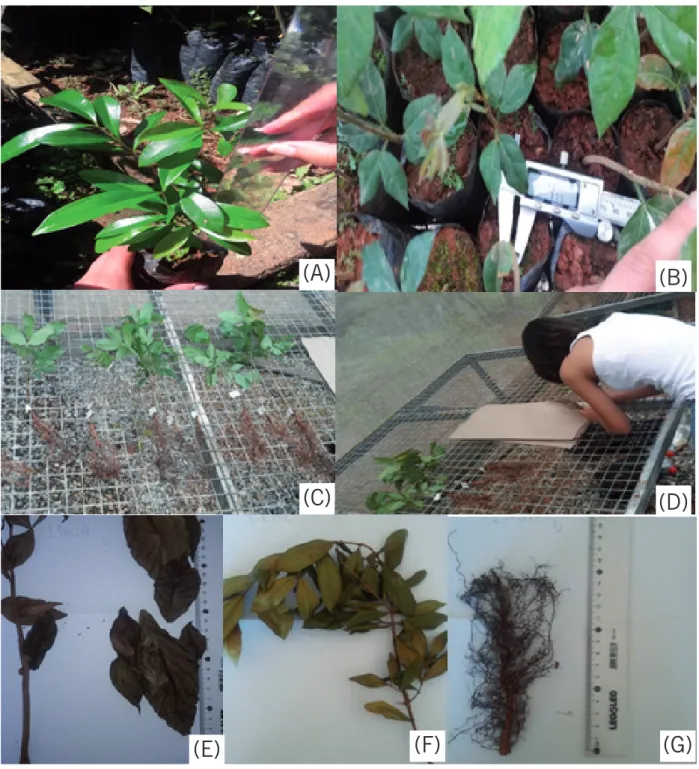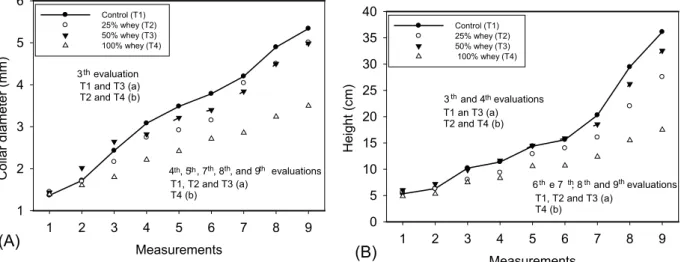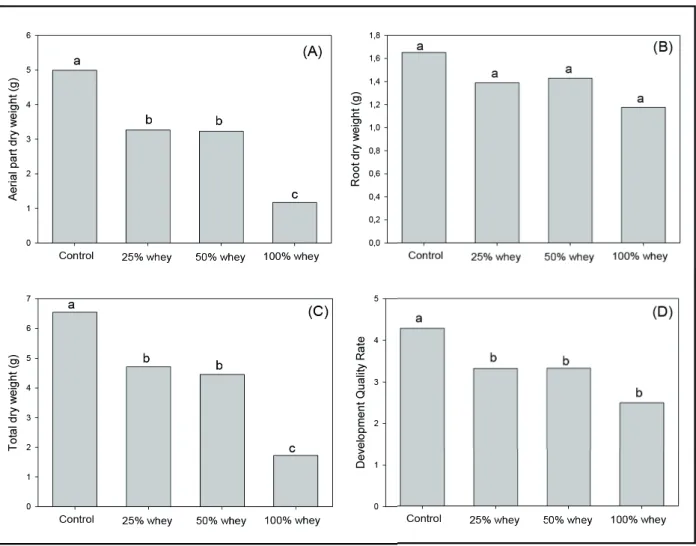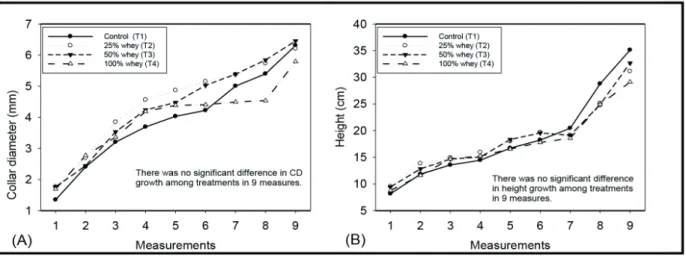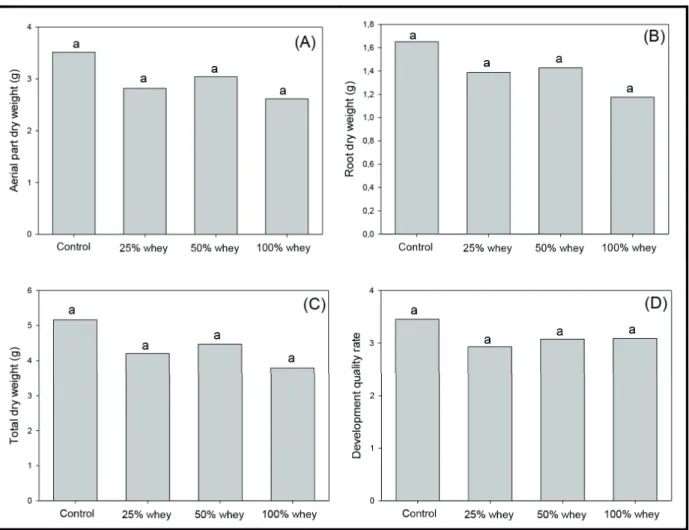Production of Inga vera Willd and Eugenia involucrata
DC. seedlings fertigated with whey
Rita de Cássia da Silva 1
Lilian Vilela Andrade Pinto2
Abstract
Residuary effluents from dairy industry contaminate hydric resources, so researches aiming sustainable methods to revert this situation must be stimulated. The objective of this study was to de-termine if whey can be used as fertigation and to define the proportion of whey that shall be fertigated for species Inga vera and Eugenia involucrata. This research consisted in two experiments, one with
Inga vera and the other with Eugenia involucrata, since the species have distinct ecological behavior,
being pioneer and late secondary, respectively. Both experiments were designed in completely rando-mized blocks and four fertigations were evaluated: T1: 100% water; T2: 25% whey and 75% water; T3: 50% whey and 50% water; and T4: 100% whey. The indicators evaluated were: plant height, collar diameter, aerial part weight, root weight, and development quality rate. Fresh whey promoted different responses in the development of Eugenia involucrata and Inga vera seedlings and the use of whey as fertigation for the species Eugenia involucrata is not recommended. Studies of irrigation using whey at the concentration of 100% is recommended for the production of Inga vera seedlings, daily or in alternate days, minimizing pressure on clean water availability.
Keywords: Effluent reuse. Native species. Atlantic Forest. Fertigation.
Introduction
Brazil is the fifth biggest milk producer country in the world (JUNG; MATTE, 2016), generating a great amount of organic residues (GIROTO; PAWLOWSKY, 2001), being them solid or liquid (CAS-TELLANOS, 2015).
The amount of residuary whey from the dairy industry (characterized as the watery portion derived from the coagulation during the conventional cheese fabrication) is, on average, from nine to twelve liters of whey for each kilogram of cheese produced (GIROTO; PAWLOWSKY, 2001), which can result in serious environmental issues associated to its high organic matter rate (OLIVEIRA; BRA-VO; TONIAL, 2012).
The milk whey is composed of some minerals such as calcium, sodium, magnesium, potas-sium, and phosphorus; and in lower quantity copper, zinc, fluorine, iodine, and iron. Great part of its composition is based on water (93-94%); lactose (4.5-5.0%); proteins (0.8-1.0%); fats (0.3-0.5%); milk vitamins; besides citric acid, lactic acid and some non-proteinaceous nitrogen compounds (urea and uric acid) (NUNES; SANTOS, 2016).
This demonstrates the necessity of a better destination to the dairy industry residues, and agri-cultural use is a sustainable option (RUIZ, 2012).
1 Instituto Federal de Educação Ciência e Tecnologia do Sul de Minas Gerais, discente em Tecnologia em Gestão Ambiental. ritacassiasilvabb@gmail.com.
Tiraden-One of the options for reusing residues from the dairy industry is using solid residues produced by the composting of organic solids as biofertilizers, without the degenerative process of the material caused by microorganisms, using only fertigation. In other words, using the irrigation of these nu-trients derived from the industrial production processes (GHERI; FERREIRA; CRUZ, 2003). The reuse of these effluents as fertilizers in the production of seedlings and vegetal species showed potential, according to Schuster (2008) and Castellanos (2015).
The Federal Institute of Education, Science and Technology of South of Minas Gerais (IFSUL-DEMINAS) – Inconfidentes campus – has a monthly milk production of 12,000 liters and a monthly mean of 6,000 liters of residuary whey generated from cheese production process, since most of the milk is commercialized after pasteurization.
Due to the necessity of reducing costs in mineral fertilizers and finding more sustainable options for the great volume of effluents, whey can be used for agricultural and silvicultural purposes acting as organic source of nutrient to plants and soil, being the most efficient and economical way for the elimination of dairy industry residues (RUIZ, 2012) and preserving natural hydric resources.
The importance of water is not related only to its functions in the nature, but also to its role as social, economic and strategic resource, providing health and life quality to people in a sustainable way. It is characterized as a common good and without this resource the metabolic processes would not occur, directly or indirectly (SOUZA et al., 2014). Therefore, society worldwide must take preser-vation of water seriously.
The objective of this study was to determine if whey can be used in fertigation and to define the whey proportion that shall be fertigated for the species Inga vera and Eugenia involucrata, which are fruit plants of different ecological groups from the Atlantic Forest biome.
Material and methods
Characterization of the area
The research was conducted in a sealed greenhouse (FIGURE 1) located in the seedling nursery at the Federal Institute of Education, Science and Technology of South of Minas Gerais (IFSULDEMI-NAS) – Inconfidentes campus. The greenhouse has a light-diffusing polyethylene film cover with 150 microns of thickness, with treatment against UV-rays, allowing a temperature higher than the external environment. The choice of the greenhouse was made in order to avoid that possible rainfall could interfere in the results since it could dilute the fertigation.
Figure 1 – Greenhouse where the experiment was conducted, located in the seedling nursery at the Federal Institute
of Education, Science and Technology of South of Minas Gerais (IFSULDEMINAS) – Inconfidentes campus.
Source: Elaborated by the authors (2017).
Seedlings from two species were evaluated: Inga vera (FIGURE 2A), and Eugenia involucrata (FIGURE 2B), species classified, in terms of ecologic group, as pioneer and late secondary, respec-tively (CARVALHO, 2008). These species present potential for their use in the recovery of degraded areas located at Atlantic Forest, because they are fruit trees attractive to the fauna and responsible for the pollination and dispersion of seeds, which are activities inherent to reforestation.
Figure 2 – Seedlings of Inga vera (A) and Eugenia involucrata (B).
Source: Elaborated by the authors (2017).
All seedlings were pricked out to 10 cm x 17 cm plastic bags three months before the selection of the sampling units of each treatment, which was made based on a visual evaluation based on the
seedlings height, aiming uniformity at the seedlings size for the treatments. Therefore, at the beginning of the experiment (mensuration 1 – zero days of whey application) the Inga vera and Eugenia involucrata seedlings presented 8.8 cm and 5.85 cm medium height and a diameter of 1.7 mm and 1.3 mm, res-pectively.
Experimental design
The research consisted in two experiments, one with Inga vera species and the other with
Eugenia involucrata species. The species were chosen considering the fact that they have different
ecological behavior, they were pioneer and late secondary, respectively. Also, the seedling production cycles are 180 and 270 days, respectively (OLIVEIRA et al., 2016). Both experiments followed a completely randomized block experimental design and four fertigation processes were evaluated: T1: 100% water; T2: 25% whey and 75% water; T3: 50% whey and 50% water; and T4: 100% whey. Every fertigation had 3 repetitions/blocks with 9 sampling units each, totaling 27 seedlings for each treatment and 108 seedlings per experiment (FIGURE 3).
The order of the treatment in the blocks was used for both species, aiming to ease the applica-tion of treatments (fertigaapplica-tion) and the measurement of seedlings (FIGURE 3). For the separaapplica-tion of parcels in the blocks, a colored wool yarn was used.
Seedlings were enumerated and the ones highlighted with a circle indicate which ones were the sampling units evaluated for monitoring aerial part and roots dry matter and seedlings development rate at the end of the experiment, after 8 months of monitoring (FIGURE 3).
Figure 3 – Sketch of the treatments distribution (T1: 100% water; T2: 254% whey and 75% water; T3: 50%
whey and 50% water; T4: 100% whey) in blocks I, II, and III, with the enumeration of the seedlings and highlight for the evaluated sampling units.
Block I 97 98 99 100 101 102 103 104 105 106 107 108 96 95 94 93 92 91 90 89 88 87 86 85 T1 73 74 75 76 77 78 79 80 81 82 83 84 T2 Block II 72 71 70 69 68 67 66 65 64 63 62 61 T3 49 50 51 52 53 54 55 56 57 58 59 60 T4 48 47 46 45 44 43 42 41 40 39 38 37 Block III 25 26 27 28 29 30 31 32 33 34 35 36 24 23 22 21 20 19 18 17 16 15 14 13 1 2 3 4 5 6 7 8 9 10 11 12
*The sampling units marked with a circle consist in those evaluated for the monitoring of aerial and roots dry matter and seedlings development rate.
Fertigation
Fertigation was conducted with whey from IFSULDEMINAS – Inconfidentes campus, which would be taken to the grease box from the sector effluent treatment system. It must be pointed out that the whey was fresh, collected in the day of fertigation application (treatments) around 11a.m. Each seedling received 90 mL of the proposed fertigation; in order to distribute the same quantity, it was used a measuring cylinder and a becker for application.
Fertigation occurred every 7 days in the first month and every 15 days after the first month of experiment conduction, which lasted 240 days (8 months of experiment and 9 measurements, the first one was used to describe the seedlings from the different treatments).
Evaluations
The seedlings growth monitoring started 30 days after the first fertigation and consisted in evaluating the morphological indicators:
- Aerial part height (H): measured monthly by a ruler, from the plant collar to the last foliar insertion, in centimeters, as shown in Figure 4A;
- Collar diameter (CD): measured the seedling monthly, using a digital caliper, in millimeters, as shown in Figure 4B;
- Aerial part dry matter weight (APDMW) and roots dry matter weight (RDMW): after being separated and washed in flowing water on a 0.02 meshed sieve, roots and aerial part were dried in the sun, in order to remove superficial water (FIGURE 4C) and wrapped separately in identified craft paper bags (FIGURE 4D). Then, they were taken to drying in a greenhouse with air renovation/circu-lation at 65ºC until they reached constant weight. This procedure took one week and during this time the craft paper bags were inverted in the spots in alternate days in order to achieve better drying and hot air circulation. The dry roots and aerial parts were removed from the bags (FIGURE 4E) and had their masses quantified in electronic analytical balance (0.001g). These indicators were quantified at 8 months after the beginning of the experiment in the sampling units highlighted in Figure 3;
- Development quality rate (DQR): at 8 months, it was determined in function of the aerial part
height (H), the collar diameter (CD), the aerial part dry matter weight (APDMW), the roots dry matter weight (RDMW), and of the total dry matter weight (TDMW = APDMW + RDMW), using the equa-tion of Dickson, Leaf and Hosner (1960) (EQUATION 1):
DQR=
Unit: dimensionless.
For determining the development quality rate (DQR), seedlings indicator highlighted with a circle were quantified, as observed in Figure 3.
TDMW(g)
Figure 4 – Procedures conducted during seedlings monitoring: A) height measurement; B) Collar diameter (CD)
measurement; C) Seedling being dried before the separation of the aerial part and root; D) identification of the craft paper bags for conditioning the aerial part and roots; E) dry roots and aerial part in greenhouse ready for mass monitoring.
Source: Elaborated by the authors (2017).
Data were submitted to variance analysis (ANOVA) and the means were compared by Scott-Knott test at 5% significance using the “Sisvar 4.2” software (FERREIRA, 2008).
(A)
(B)
(D)
(C)
(G)
(F)
(E)
Results and discussions
The data for collar height and diameter of Eugenia involucrata and Inga vera seedlings corres-pond to the 8 months of the experiment (from February, 2017 to October, 2017), period in which the seedlings received fertigation with residuary whey from the dairy industry.
Eugenia involucrata DC.
The seedlings collar diameter presented distinctive growth (p < 0.05) for the treatments after the second month (3rd measurement), which consisted of application of whey fertigation superior in treatments T1 (100% water) and T3 (50% whey and 50% water). From the third month of whey application (4th measurement) to the end of the experiment, only the treatment T4 (100% whey) inhibited growth of CD (FIGURE 5A).
Regarding height, seedlings presented variation in the second and third months (3rd and 4th me-asurements) of whey application, having reached the highest heights in treatments T1 (100% water) and T3 (50% whey and 50% water). From the fifth month (6th measurement) of whey application to the end of the experiment, only treatment T4 (100% whey) inhibited height growth (FIGURE 5B).
Figure 5 – Evaluations of growth indicators collar diameter (A) and height (B) for species Eugenia involucrata
DC. submitted to different fertigations. IFSULDEMINAS – Inconfidentes campus. Inconfidentes, Minas Gerais state, Brazil, 2017. Means followed by the same letter did not differ significantly by the Scott-Knott test at 5% of probability. Measurements 1 2 3 4 5 6 7 8 9 C ol lar di am et er (m m ) 1 2 3 4 5 6 Control (T1) 25% whey (T2) 50% whey (T3) 100% whey (T4) T1 and T3 (a) T2 and T4 (b) T1, T2 and T3 (a) T4 (b) 3 evaluation 4 , 5 , 7 , 8 , and 9 evaluations (A) th th th th th th Measurements 1 2 3 4 5 6 7 8 9 H ei ght (c m ) 0 5 10 15 20 25 30 35 40 Control (T1) 25% whey (T2) 50% whey (T3) 100% whey (T4) T1 an T3 (a) T2 and T4 (b) T1, T2 and T3 (a) T4 (b) 3 and 4 evaluations 6 e 7 , 8 and 9 evaluations (B) th th th th th th
Source: Elaborated by the authors (2017).
The aerial part dry matter weight (APDMW) (FIGURE 6A) presented by the T1 seedlings (100% water) was statistically superior (p > 0.05) to the other treatments, being, on average, 36% higher than the values observed for T2 (25% whey and 75% water) and T3 (50% whey and 50% water) - which did not differ from each other - and 77% higher than the values observed for T4 (100% whey). Figure 6A demonstrates that the application of 100% whey (T4) strongly inhibited the growth of seedlings aerial part.
The root dry matter weight (RDMW) (FIGURE 6B) suffered less interference by the whey appli-cation when compared to APDMW. This affirmation comes from the fact that in the doses of treatment T2 (25% whey and 75% water) and T3 (50% whey and 50% water), it was not observed values
of RDMW inferior to control (T1: 100% water), difference observed for APDMW. The application of 100% whey (T4) also strongly inhibited seedling roots growth, promoting a reduction of at least 55% in RDMW.
Figure 6 – Evaluation of indicator for aerial part dry matter weight – APDMW (A), root dry matter weight –
RDMW (B), total dry matter weight – TDMW (C), and development quality rate – DQR (D) for the species
Eugenia involucrata DC. submitted to different fertigation processes. IFSULDEMINAS – Inconfidentes campus.
Inconfidentes, Minas Gerais state, Brazil, 2017. Means followed by the same letter did not differ significantly by the Scott-Knott test at 5% of probability.
Source: Elaborated by the authors (2017).
The total dry weight (TDMW) (FIGURE 6C) presented statistical results similar to APDMW, at which T1 seedlings (100% water) developed better than the other treatments, being 25% superior in relation to treatment T2 (25% whey and 75% water) and 32% greater than T3 (50% whey and 50% water) - which did not present statistical differences from each other - and 74% greater than T4 (100% whey), statistically different from all treatments evaluated.
The development quality rate (DQR) (FIGURE 6D) is an excellent quality indicator for consider-ing vigor (H and CD) and distribution balance of biomass in the seedlconsider-ing (APDMW and RDMW). This indicator revealed that T1 (100% water) presented the best condition among the studied treatments, which took different portions of whey for the production of Eugenia involucrata DC. seedlings.
Eugenia involucrata requires well-drained soils and of high chemical fertility (CARVALHO,
2008). Hence, it was expected a satisfactory response from the development of the seedlings of this species in the presence of residuary whey, since Nunes and Santos (2016) stated that this residue presents macro and micro nutrients: calcium, sodium, magnesium, potassium, and phosphorus; and in lower concentrations: copper, zinc, fluorine, iodine, and iron, alongside some nitrogen compounds (urea and uric acid). However, it was observed toxicity of whey in the concentrations 25% (T2), 50% (T3) and 100% (T4) applied as fertigation, causing damages to seedlings development.
Similar results were observed by Daló Júnior (2016) in the production of Eugenia pyriformis seedlings and by Paula (2009) in the cultivation of hydroponic maize forage, who observed that the increase of whey dosages linearly damaged Eugenia pyriformis seedlings growth and the weight of fresh matter and aerial part dry matter of maize.
Inga vera Willd
The collar diameter (CD) (FIGURE 7A) and height (H) (FIGURE 7B) values of Inga vera seedlin-gs submitted to different fertigation processes (T1: 100% water; T2: 25% whey and 75% water; T3: 50% whey and 50% water; T4: 100% whey) did not present significant changes (p < 0.05) over the monthly measuring in the 8 months of the experiment.
Figure 7 – Evaluations of growth indicators collar diameter (A) and height (B) for Inga vera Willd submitted
to different fertigation processes IFSULDEMINAS – Inconfidentes campus. Inconfidentes, Minas Gerais state, Brazil, 2017. Means followed by the same letter did not significantly differ by Scott-Knott test at 5% of probability.
Source: Elaborated by the authors (2017).
The values for aerial part dry matter weight (APDMW), root dry matter weight (RDMW), total dry matter weight (TDMW), and development quality rate (DQR) did not present significant changes in the 8 months of the experiment conduction (FIGURES 8A, 8B, 8C, and 8D).
Thus, it is stated that the application of different doses of whey do not affect the development of pioneer species Inga vera Willd seedlings. In other words, it does not enhance neither causes damage when compared to control (T1: 100% water). These results are different from the ones observed for the species Eugenia involucrata, which presented damaged development for all dosages evaluated. These results are also different from the ones found by Gheri, Ferreira and Cruz (2003), who, after application of acid whey on Panicum maximum, found increase in the production of dry matter,
achieving higher production after application of 390 m³/ha of whey; by Schuster (2008), who tested daily irrigation of 200 mL and 400 mL in eucalyptus seedlings, the author observed an increase in height and collar diameter with application of a higher dosage; and by Mantovani et al. (2015), who evaluated the whey potential as source of nutrients for maize and observed that the acid whey on the soil increases the production of maize plants dry matter and the accumulations of N, P, K, and Ca in the aerial part, if used whey in values superior to 200 m³ ha -1.
Figure 8 – Evaluation of indicators for aerial part dry matter weight (APDMW) (A), root dry matter weight
(RDMW) (B), total dry matter (TDMW) (C), and development quality rate (DQR) for the species Inga vera Willd submitted to different fertigations. IFSULDEMINAS – Inconfidentes campus. Inconfidentes, Minas Gerais state, Brazil, 2017. Means followed by the same letter did not differ significantly by Scott-Knott test at 5% probability.
Source: Elaborated by the authors (2017).
The purpose of this study was to use whey as fertigation in order to avoid the use of artificial fertilizers. However, due to the results observed for the pioneer species Inga vera, it is recommended for that ecologic group the reuse of whey substituting irrigation by clean water, corroborating Kummer (2012) reports, in which is pointed out that in order to supply the necessity of water usage, since water is scarce frequently, there is a need of appealing to inferior quality water.
Conclusion
Fresh whey promoted different responses to the development of species Eugenia involucrata and Inga vera seedlings, not being recommended the use of whey as fertigation for the species
Eu-genia involucrata.
It is recommended irrigation studies using whey in a 100% concentration for the production of Inga vera seedlings daily or in alternate days, reducing the pressure for availability of clean water.
We suggest more researches about whey being evaluated as irrigation for other pioneer species as an option of reuse for this residue, aiming to decrease clean water consumption. We also recom-mend researches addressing better whey concentration for tree species that are tolerant to a great load of nutrients.
However, this study justified itself for two reasons: reducing residues in the environment and reducing necessity for clean water usage.
Acknowledgments
To the Federal Institute of Education, Science and Technology of South of Minas Gerais (IFSUL-DEMINAS), for the financial support granted.
